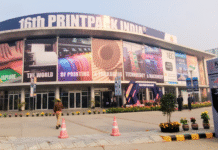
The second day of Media Expo 2023 saw an enlightening session on sustainable advertising with a focus on textile-based media. Santosh Nair, CEO, Skytech Group, who moderated the discussion, shared a piece of alarming statistics. According to a study by ICRA (Investment Information and Credit Rating Agency) in 2018, 18,000 tons of PVC flex banners are consumed and dumped into landfills every month, he said.
To address the issue and discuss solutions, Nair had on stage Avinash Misar, CEO, Texport Syndicate; T Vinoth Kumar, managing partner, Coatex; Arindam Dasgupta, vice-president, Hearth Textiles and Deepak Girotra, director, Sun Printable Fabric, as panelists. All experts explored the future of advertising, going deep into the possibilities and the potential of environment-friendly textile-based solutions for brands instead of PVC.
PVC has been the go-to material for banners and signage due to its durability and cost-effectiveness. However, its environmental impact has raised concerns — pushing the industry to seek alternatives.
Sharing the challenges he faced when he first tried out the alternatives, Misar said, “When introduced in 2015, the market was not ready to accept textile-based flex. In the last couple of years, the penetration has increased but the rate is too slow.”
Misar said there should be standardization of the process, technologies, and materials used to ensure consistency and quality across the board. “When everybody operates on the same platform, it becomes easier for brands to make informed choices and for consumers to understand and appreciate the benefits of sustainable alternatives.”
Based on his experience of convincing people in the industry to move towards sustainable means instead of PVC, Kumar said, “The convincing part is difficult as people are very much comfortable with PVC because of low cost, affordability, and availability. In 2015, the Kerala government banned PVC, forcing advertisers and printers to look for textile-based alternatives.”
Kumar said Kerala printers shifted toward textile-based media after the PVC ban. “Now they are not ready for PVC prints.”
Dasgupta said returning to a cleaner planet may become impossible if we don’t act now. “When the initiative started, the industry didn’t know much about the new printing systems and materials. But now, the industry is well aware of the process due to various regulations introduced by the government.”
He emphasized the need for all stakeholders to share the responsibility of the journey towards sustainability — be it brands, the governments, printers, or the consumers.
Girotra said fabric banners can be printed on the same machine that prints PVC flex. He believes the quality of fabric print is far superior to PVC. “The technicalities of printing on fabric are different but not difficult. It is just a matter of practice,” Girotra said.
Girotra highlighted the diverse range of fabrics with different price points. This variety gives the consumer a chance to do his bit for a sustainable environment within budget without compromising on quality, he said.















